Audit Assignment: Ethical Principles, Threats, and Audit Reports
VerifiedAdded on 2020/04/07
|10
|2734
|78
Homework Assignment
AI Summary
This assignment solution provides a detailed analysis of various scenarios related to auditing. It begins by examining ethical principles, including confidentiality, professional competence and due care, professional behavior, and objectivity, and assesses whether these principles are violated in specific cases. The solution then explores different types of threats to auditor independence, such as self-review, self-interest, and familiarity threats, providing examples of each. Finally, the assignment delves into the components of an audit report, outlining the scope of the audit and the responsibilities of the auditor, including the auditor's opinion on the financial statements and the compliance with relevant standards and regulations. The solution highlights the importance of ethical conduct and independence in the auditing process.
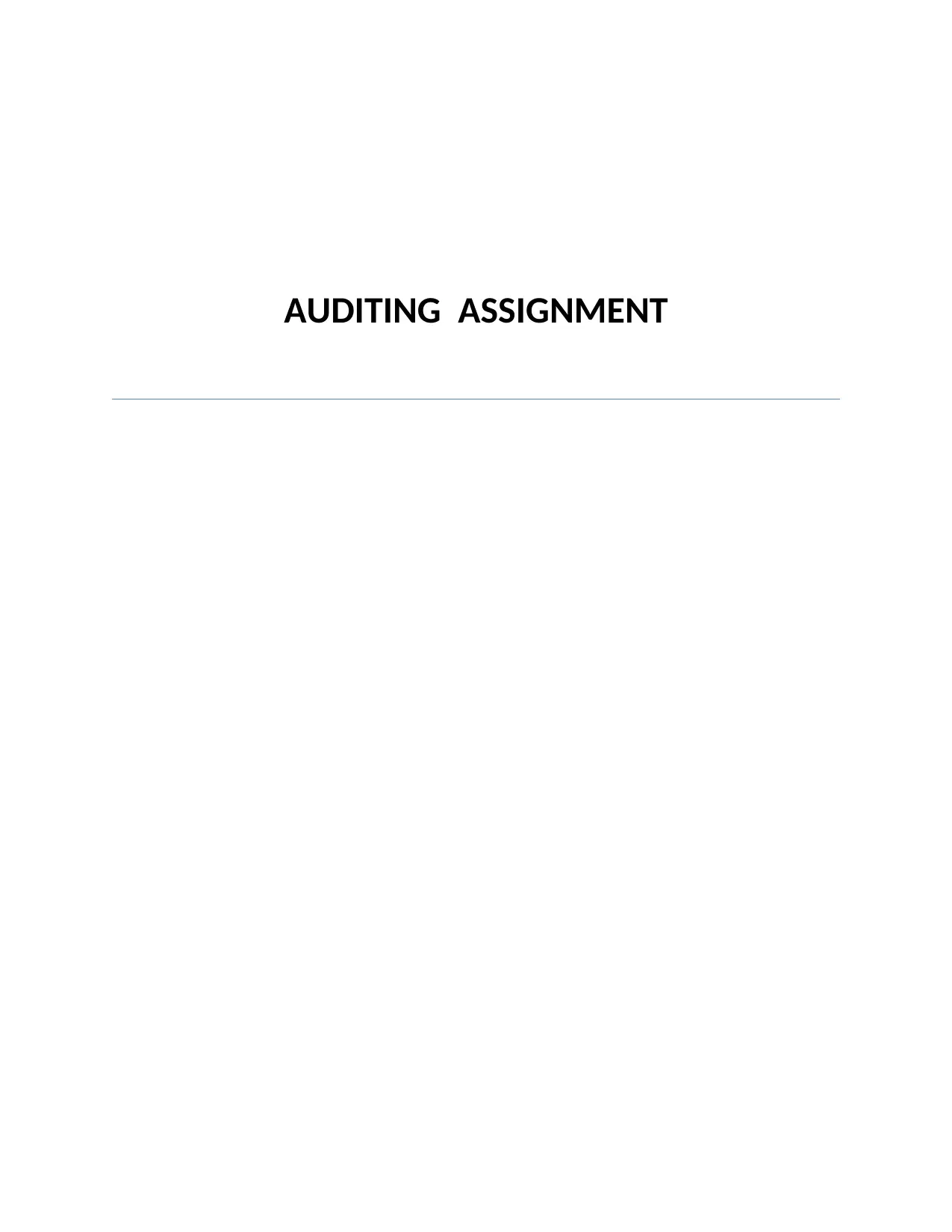
AUDITING ASSIGNMENT
Paraphrase This Document
Need a fresh take? Get an instant paraphrase of this document with our AI Paraphraser
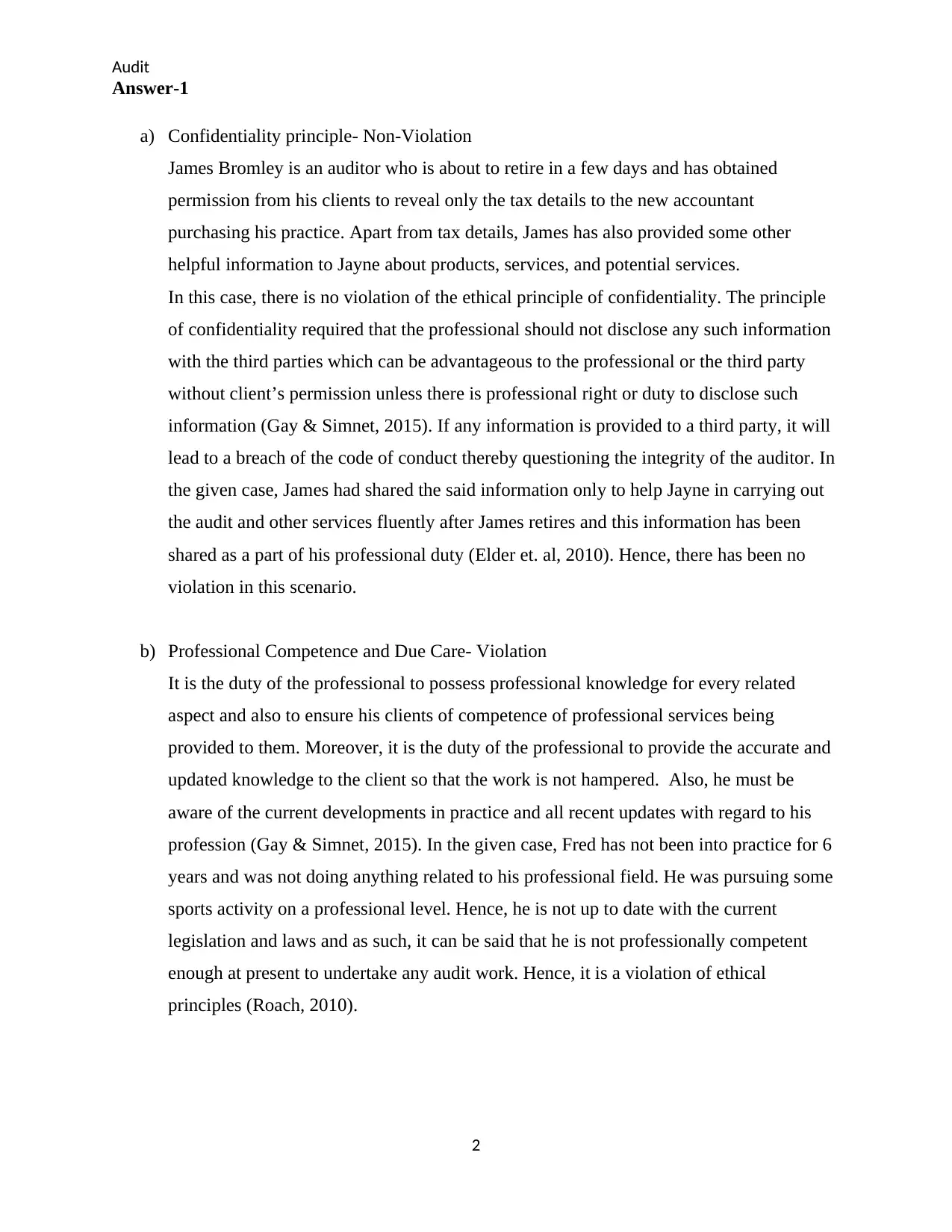
Audit
Answer-1
a) Confidentiality principle- Non-Violation
James Bromley is an auditor who is about to retire in a few days and has obtained
permission from his clients to reveal only the tax details to the new accountant
purchasing his practice. Apart from tax details, James has also provided some other
helpful information to Jayne about products, services, and potential services.
In this case, there is no violation of the ethical principle of confidentiality. The principle
of confidentiality required that the professional should not disclose any such information
with the third parties which can be advantageous to the professional or the third party
without client’s permission unless there is professional right or duty to disclose such
information (Gay & Simnet, 2015). If any information is provided to a third party, it will
lead to a breach of the code of conduct thereby questioning the integrity of the auditor. In
the given case, James had shared the said information only to help Jayne in carrying out
the audit and other services fluently after James retires and this information has been
shared as a part of his professional duty (Elder et. al, 2010). Hence, there has been no
violation in this scenario.
b) Professional Competence and Due Care- Violation
It is the duty of the professional to possess professional knowledge for every related
aspect and also to ensure his clients of competence of professional services being
provided to them. Moreover, it is the duty of the professional to provide the accurate and
updated knowledge to the client so that the work is not hampered. Also, he must be
aware of the current developments in practice and all recent updates with regard to his
profession (Gay & Simnet, 2015). In the given case, Fred has not been into practice for 6
years and was not doing anything related to his professional field. He was pursuing some
sports activity on a professional level. Hence, he is not up to date with the current
legislation and laws and as such, it can be said that he is not professionally competent
enough at present to undertake any audit work. Hence, it is a violation of ethical
principles (Roach, 2010).
2
Answer-1
a) Confidentiality principle- Non-Violation
James Bromley is an auditor who is about to retire in a few days and has obtained
permission from his clients to reveal only the tax details to the new accountant
purchasing his practice. Apart from tax details, James has also provided some other
helpful information to Jayne about products, services, and potential services.
In this case, there is no violation of the ethical principle of confidentiality. The principle
of confidentiality required that the professional should not disclose any such information
with the third parties which can be advantageous to the professional or the third party
without client’s permission unless there is professional right or duty to disclose such
information (Gay & Simnet, 2015). If any information is provided to a third party, it will
lead to a breach of the code of conduct thereby questioning the integrity of the auditor. In
the given case, James had shared the said information only to help Jayne in carrying out
the audit and other services fluently after James retires and this information has been
shared as a part of his professional duty (Elder et. al, 2010). Hence, there has been no
violation in this scenario.
b) Professional Competence and Due Care- Violation
It is the duty of the professional to possess professional knowledge for every related
aspect and also to ensure his clients of competence of professional services being
provided to them. Moreover, it is the duty of the professional to provide the accurate and
updated knowledge to the client so that the work is not hampered. Also, he must be
aware of the current developments in practice and all recent updates with regard to his
profession (Gay & Simnet, 2015). In the given case, Fred has not been into practice for 6
years and was not doing anything related to his professional field. He was pursuing some
sports activity on a professional level. Hence, he is not up to date with the current
legislation and laws and as such, it can be said that he is not professionally competent
enough at present to undertake any audit work. Hence, it is a violation of ethical
principles (Roach, 2010).
2
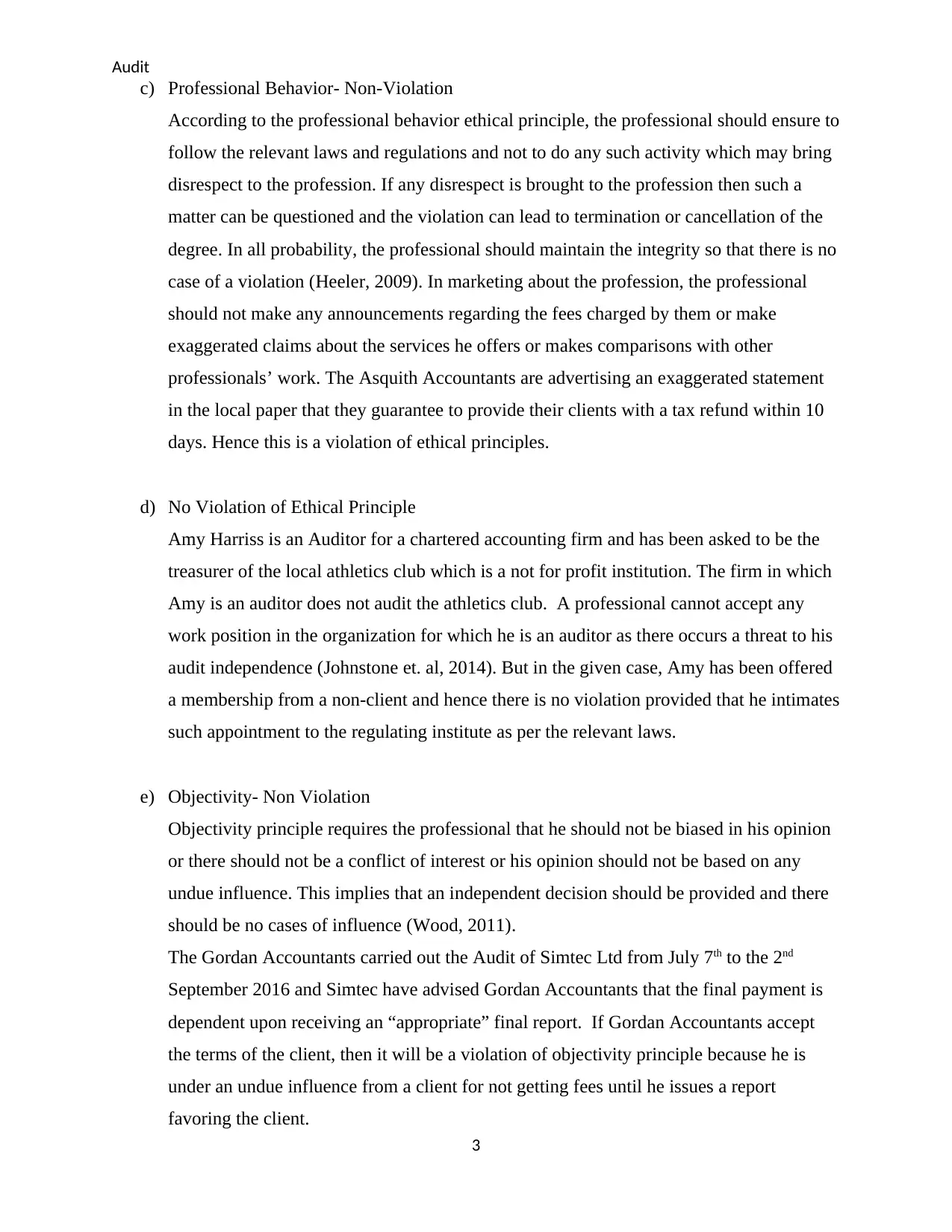
Audit
c) Professional Behavior- Non-Violation
According to the professional behavior ethical principle, the professional should ensure to
follow the relevant laws and regulations and not to do any such activity which may bring
disrespect to the profession. If any disrespect is brought to the profession then such a
matter can be questioned and the violation can lead to termination or cancellation of the
degree. In all probability, the professional should maintain the integrity so that there is no
case of a violation (Heeler, 2009). In marketing about the profession, the professional
should not make any announcements regarding the fees charged by them or make
exaggerated claims about the services he offers or makes comparisons with other
professionals’ work. The Asquith Accountants are advertising an exaggerated statement
in the local paper that they guarantee to provide their clients with a tax refund within 10
days. Hence this is a violation of ethical principles.
d) No Violation of Ethical Principle
Amy Harriss is an Auditor for a chartered accounting firm and has been asked to be the
treasurer of the local athletics club which is a not for profit institution. The firm in which
Amy is an auditor does not audit the athletics club. A professional cannot accept any
work position in the organization for which he is an auditor as there occurs a threat to his
audit independence (Johnstone et. al, 2014). But in the given case, Amy has been offered
a membership from a non-client and hence there is no violation provided that he intimates
such appointment to the regulating institute as per the relevant laws.
e) Objectivity- Non Violation
Objectivity principle requires the professional that he should not be biased in his opinion
or there should not be a conflict of interest or his opinion should not be based on any
undue influence. This implies that an independent decision should be provided and there
should be no cases of influence (Wood, 2011).
The Gordan Accountants carried out the Audit of Simtec Ltd from July 7th to the 2nd
September 2016 and Simtec have advised Gordan Accountants that the final payment is
dependent upon receiving an “appropriate” final report. If Gordan Accountants accept
the terms of the client, then it will be a violation of objectivity principle because he is
under an undue influence from a client for not getting fees until he issues a report
favoring the client.
3
c) Professional Behavior- Non-Violation
According to the professional behavior ethical principle, the professional should ensure to
follow the relevant laws and regulations and not to do any such activity which may bring
disrespect to the profession. If any disrespect is brought to the profession then such a
matter can be questioned and the violation can lead to termination or cancellation of the
degree. In all probability, the professional should maintain the integrity so that there is no
case of a violation (Heeler, 2009). In marketing about the profession, the professional
should not make any announcements regarding the fees charged by them or make
exaggerated claims about the services he offers or makes comparisons with other
professionals’ work. The Asquith Accountants are advertising an exaggerated statement
in the local paper that they guarantee to provide their clients with a tax refund within 10
days. Hence this is a violation of ethical principles.
d) No Violation of Ethical Principle
Amy Harriss is an Auditor for a chartered accounting firm and has been asked to be the
treasurer of the local athletics club which is a not for profit institution. The firm in which
Amy is an auditor does not audit the athletics club. A professional cannot accept any
work position in the organization for which he is an auditor as there occurs a threat to his
audit independence (Johnstone et. al, 2014). But in the given case, Amy has been offered
a membership from a non-client and hence there is no violation provided that he intimates
such appointment to the regulating institute as per the relevant laws.
e) Objectivity- Non Violation
Objectivity principle requires the professional that he should not be biased in his opinion
or there should not be a conflict of interest or his opinion should not be based on any
undue influence. This implies that an independent decision should be provided and there
should be no cases of influence (Wood, 2011).
The Gordan Accountants carried out the Audit of Simtec Ltd from July 7th to the 2nd
September 2016 and Simtec have advised Gordan Accountants that the final payment is
dependent upon receiving an “appropriate” final report. If Gordan Accountants accept
the terms of the client, then it will be a violation of objectivity principle because he is
under an undue influence from a client for not getting fees until he issues a report
favoring the client.
3
⊘ This is a preview!⊘
Do you want full access?
Subscribe today to unlock all pages.

Trusted by 1+ million students worldwide
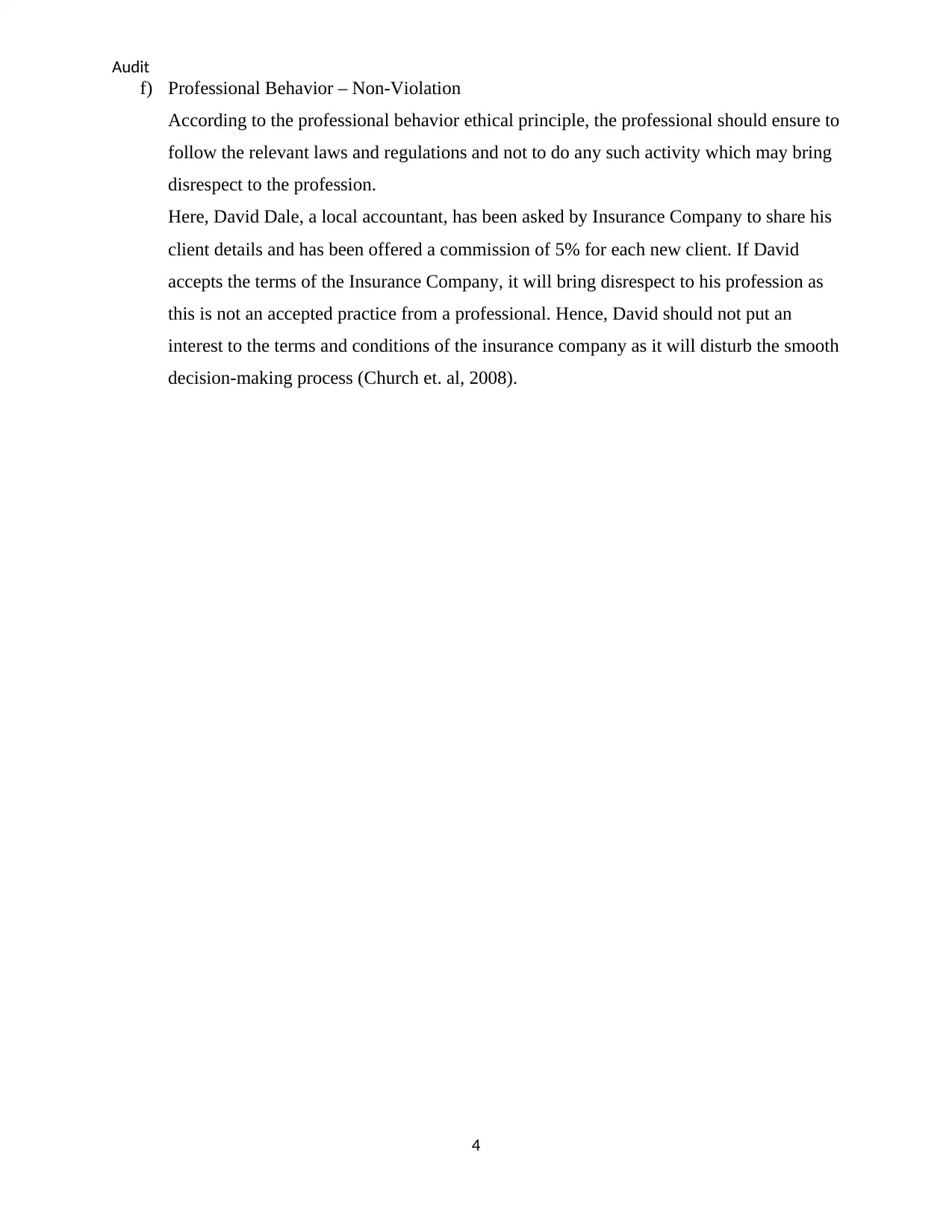
Audit
f) Professional Behavior – Non-Violation
According to the professional behavior ethical principle, the professional should ensure to
follow the relevant laws and regulations and not to do any such activity which may bring
disrespect to the profession.
Here, David Dale, a local accountant, has been asked by Insurance Company to share his
client details and has been offered a commission of 5% for each new client. If David
accepts the terms of the Insurance Company, it will bring disrespect to his profession as
this is not an accepted practice from a professional. Hence, David should not put an
interest to the terms and conditions of the insurance company as it will disturb the smooth
decision-making process (Church et. al, 2008).
4
f) Professional Behavior – Non-Violation
According to the professional behavior ethical principle, the professional should ensure to
follow the relevant laws and regulations and not to do any such activity which may bring
disrespect to the profession.
Here, David Dale, a local accountant, has been asked by Insurance Company to share his
client details and has been offered a commission of 5% for each new client. If David
accepts the terms of the Insurance Company, it will bring disrespect to his profession as
this is not an accepted practice from a professional. Hence, David should not put an
interest to the terms and conditions of the insurance company as it will disturb the smooth
decision-making process (Church et. al, 2008).
4
Paraphrase This Document
Need a fresh take? Get an instant paraphrase of this document with our AI Paraphraser
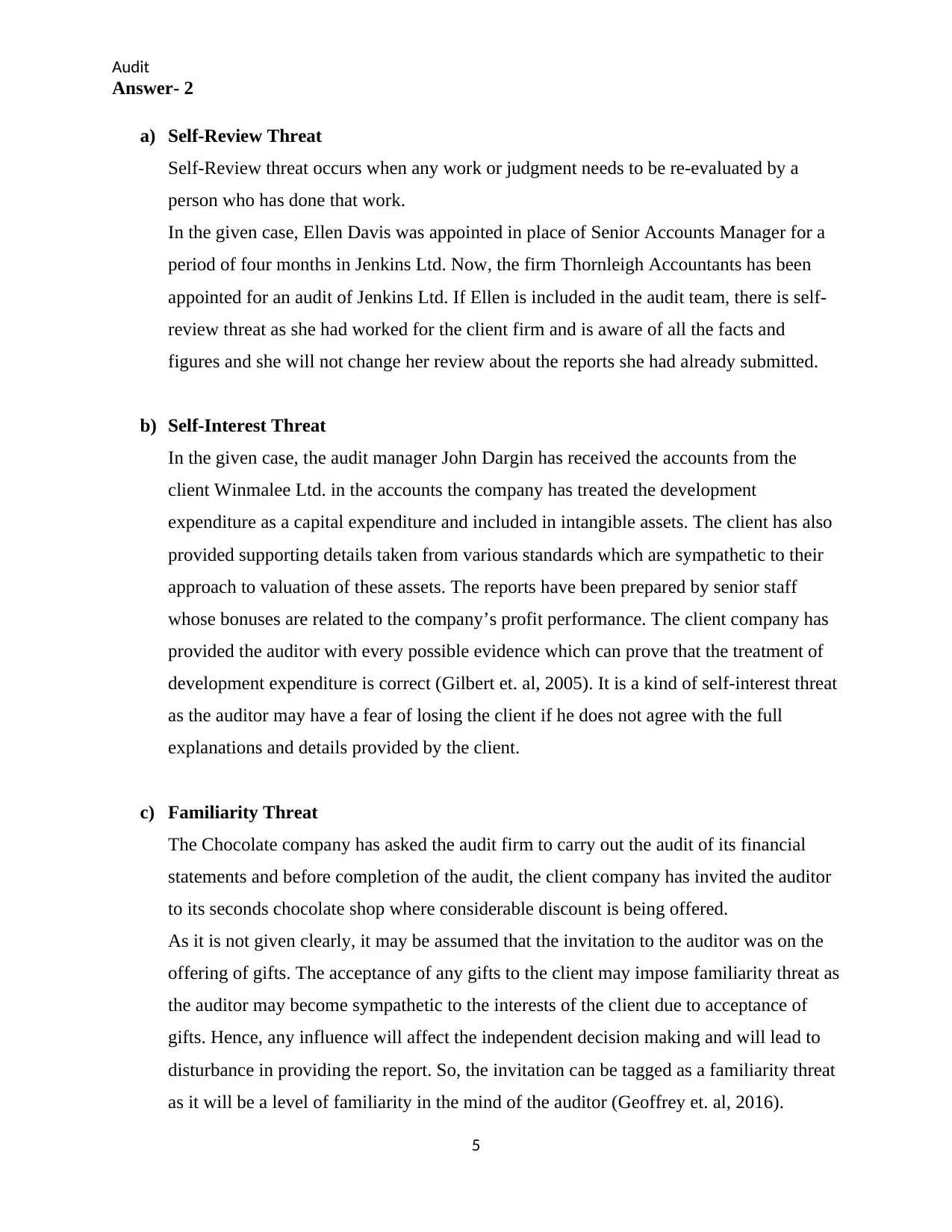
Audit
Answer- 2
a) Self-Review Threat
Self-Review threat occurs when any work or judgment needs to be re-evaluated by a
person who has done that work.
In the given case, Ellen Davis was appointed in place of Senior Accounts Manager for a
period of four months in Jenkins Ltd. Now, the firm Thornleigh Accountants has been
appointed for an audit of Jenkins Ltd. If Ellen is included in the audit team, there is self-
review threat as she had worked for the client firm and is aware of all the facts and
figures and she will not change her review about the reports she had already submitted.
b) Self-Interest Threat
In the given case, the audit manager John Dargin has received the accounts from the
client Winmalee Ltd. in the accounts the company has treated the development
expenditure as a capital expenditure and included in intangible assets. The client has also
provided supporting details taken from various standards which are sympathetic to their
approach to valuation of these assets. The reports have been prepared by senior staff
whose bonuses are related to the company’s profit performance. The client company has
provided the auditor with every possible evidence which can prove that the treatment of
development expenditure is correct (Gilbert et. al, 2005). It is a kind of self-interest threat
as the auditor may have a fear of losing the client if he does not agree with the full
explanations and details provided by the client.
c) Familiarity Threat
The Chocolate company has asked the audit firm to carry out the audit of its financial
statements and before completion of the audit, the client company has invited the auditor
to its seconds chocolate shop where considerable discount is being offered.
As it is not given clearly, it may be assumed that the invitation to the auditor was on the
offering of gifts. The acceptance of any gifts to the client may impose familiarity threat as
the auditor may become sympathetic to the interests of the client due to acceptance of
gifts. Hence, any influence will affect the independent decision making and will lead to
disturbance in providing the report. So, the invitation can be tagged as a familiarity threat
as it will be a level of familiarity in the mind of the auditor (Geoffrey et. al, 2016).
5
Answer- 2
a) Self-Review Threat
Self-Review threat occurs when any work or judgment needs to be re-evaluated by a
person who has done that work.
In the given case, Ellen Davis was appointed in place of Senior Accounts Manager for a
period of four months in Jenkins Ltd. Now, the firm Thornleigh Accountants has been
appointed for an audit of Jenkins Ltd. If Ellen is included in the audit team, there is self-
review threat as she had worked for the client firm and is aware of all the facts and
figures and she will not change her review about the reports she had already submitted.
b) Self-Interest Threat
In the given case, the audit manager John Dargin has received the accounts from the
client Winmalee Ltd. in the accounts the company has treated the development
expenditure as a capital expenditure and included in intangible assets. The client has also
provided supporting details taken from various standards which are sympathetic to their
approach to valuation of these assets. The reports have been prepared by senior staff
whose bonuses are related to the company’s profit performance. The client company has
provided the auditor with every possible evidence which can prove that the treatment of
development expenditure is correct (Gilbert et. al, 2005). It is a kind of self-interest threat
as the auditor may have a fear of losing the client if he does not agree with the full
explanations and details provided by the client.
c) Familiarity Threat
The Chocolate company has asked the audit firm to carry out the audit of its financial
statements and before completion of the audit, the client company has invited the auditor
to its seconds chocolate shop where considerable discount is being offered.
As it is not given clearly, it may be assumed that the invitation to the auditor was on the
offering of gifts. The acceptance of any gifts to the client may impose familiarity threat as
the auditor may become sympathetic to the interests of the client due to acceptance of
gifts. Hence, any influence will affect the independent decision making and will lead to
disturbance in providing the report. So, the invitation can be tagged as a familiarity threat
as it will be a level of familiarity in the mind of the auditor (Geoffrey et. al, 2016).
5
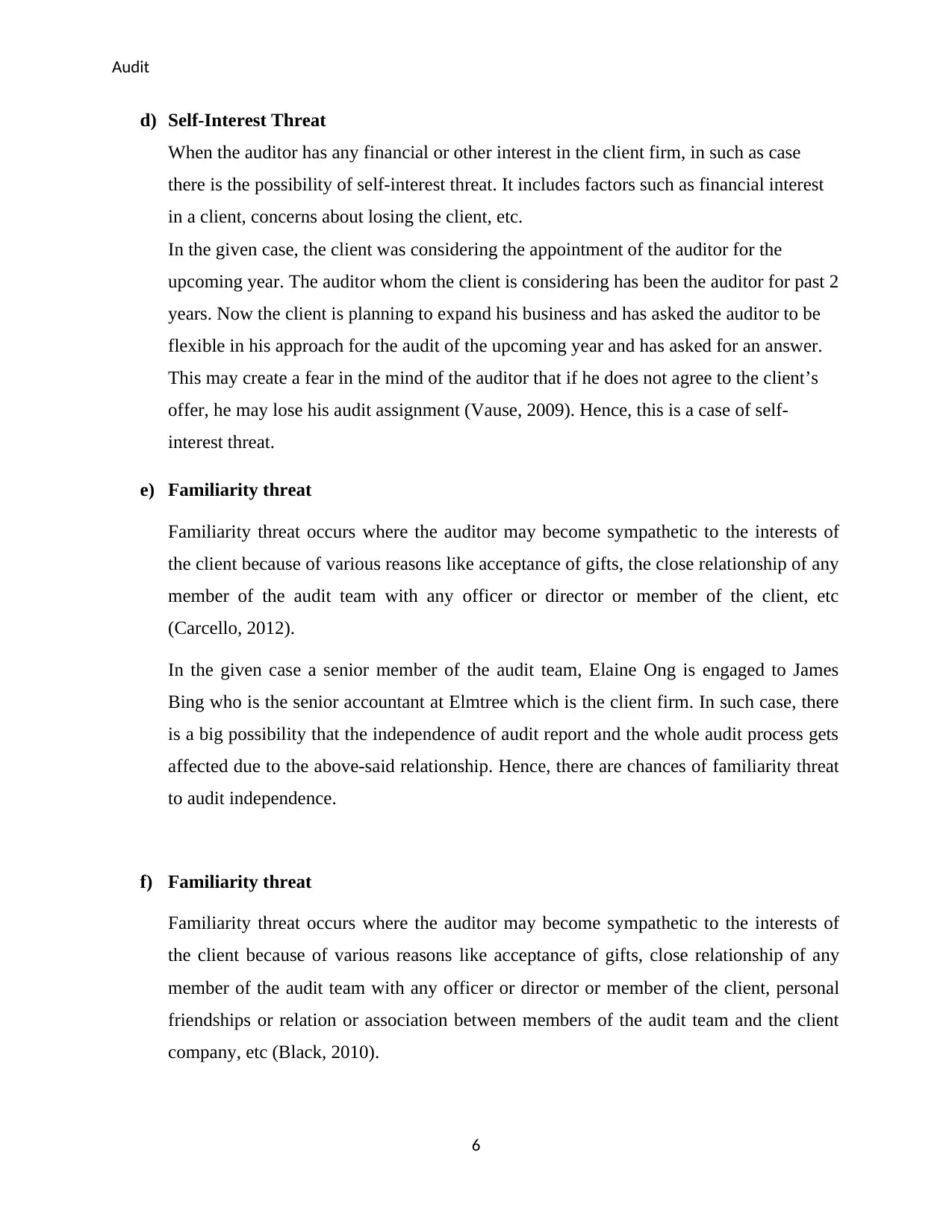
Audit
d) Self-Interest Threat
When the auditor has any financial or other interest in the client firm, in such as case
there is the possibility of self-interest threat. It includes factors such as financial interest
in a client, concerns about losing the client, etc.
In the given case, the client was considering the appointment of the auditor for the
upcoming year. The auditor whom the client is considering has been the auditor for past 2
years. Now the client is planning to expand his business and has asked the auditor to be
flexible in his approach for the audit of the upcoming year and has asked for an answer.
This may create a fear in the mind of the auditor that if he does not agree to the client’s
offer, he may lose his audit assignment (Vause, 2009). Hence, this is a case of self-
interest threat.
e) Familiarity threat
Familiarity threat occurs where the auditor may become sympathetic to the interests of
the client because of various reasons like acceptance of gifts, the close relationship of any
member of the audit team with any officer or director or member of the client, etc
(Carcello, 2012).
In the given case a senior member of the audit team, Elaine Ong is engaged to James
Bing who is the senior accountant at Elmtree which is the client firm. In such case, there
is a big possibility that the independence of audit report and the whole audit process gets
affected due to the above-said relationship. Hence, there are chances of familiarity threat
to audit independence.
f) Familiarity threat
Familiarity threat occurs where the auditor may become sympathetic to the interests of
the client because of various reasons like acceptance of gifts, close relationship of any
member of the audit team with any officer or director or member of the client, personal
friendships or relation or association between members of the audit team and the client
company, etc (Black, 2010).
6
d) Self-Interest Threat
When the auditor has any financial or other interest in the client firm, in such as case
there is the possibility of self-interest threat. It includes factors such as financial interest
in a client, concerns about losing the client, etc.
In the given case, the client was considering the appointment of the auditor for the
upcoming year. The auditor whom the client is considering has been the auditor for past 2
years. Now the client is planning to expand his business and has asked the auditor to be
flexible in his approach for the audit of the upcoming year and has asked for an answer.
This may create a fear in the mind of the auditor that if he does not agree to the client’s
offer, he may lose his audit assignment (Vause, 2009). Hence, this is a case of self-
interest threat.
e) Familiarity threat
Familiarity threat occurs where the auditor may become sympathetic to the interests of
the client because of various reasons like acceptance of gifts, the close relationship of any
member of the audit team with any officer or director or member of the client, etc
(Carcello, 2012).
In the given case a senior member of the audit team, Elaine Ong is engaged to James
Bing who is the senior accountant at Elmtree which is the client firm. In such case, there
is a big possibility that the independence of audit report and the whole audit process gets
affected due to the above-said relationship. Hence, there are chances of familiarity threat
to audit independence.
f) Familiarity threat
Familiarity threat occurs where the auditor may become sympathetic to the interests of
the client because of various reasons like acceptance of gifts, close relationship of any
member of the audit team with any officer or director or member of the client, personal
friendships or relation or association between members of the audit team and the client
company, etc (Black, 2010).
6
⊘ This is a preview!⊘
Do you want full access?
Subscribe today to unlock all pages.

Trusted by 1+ million students worldwide
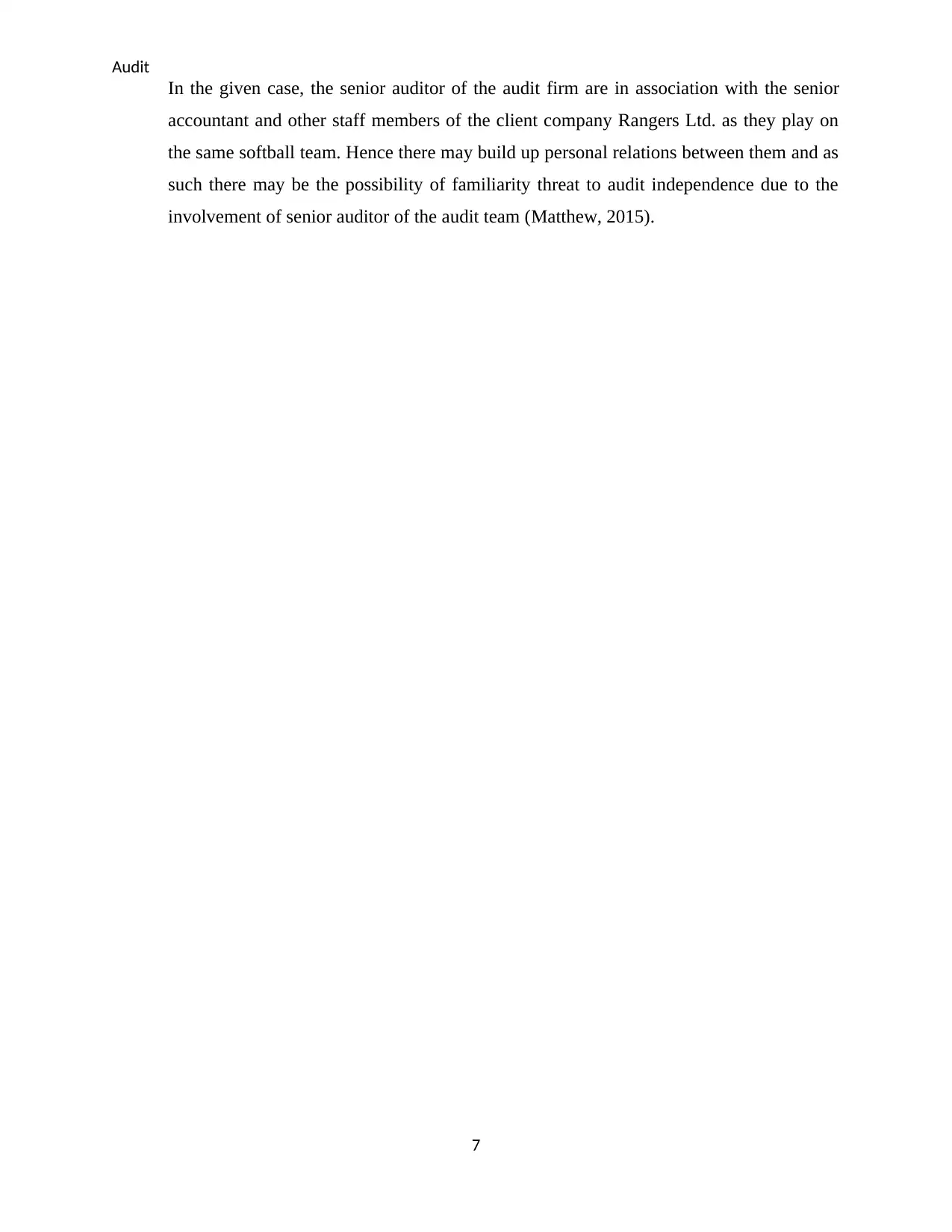
Audit
In the given case, the senior auditor of the audit firm are in association with the senior
accountant and other staff members of the client company Rangers Ltd. as they play on
the same softball team. Hence there may build up personal relations between them and as
such there may be the possibility of familiarity threat to audit independence due to the
involvement of senior auditor of the audit team (Matthew, 2015).
7
In the given case, the senior auditor of the audit firm are in association with the senior
accountant and other staff members of the client company Rangers Ltd. as they play on
the same softball team. Hence there may build up personal relations between them and as
such there may be the possibility of familiarity threat to audit independence due to the
involvement of senior auditor of the audit team (Matthew, 2015).
7
Paraphrase This Document
Need a fresh take? Get an instant paraphrase of this document with our AI Paraphraser
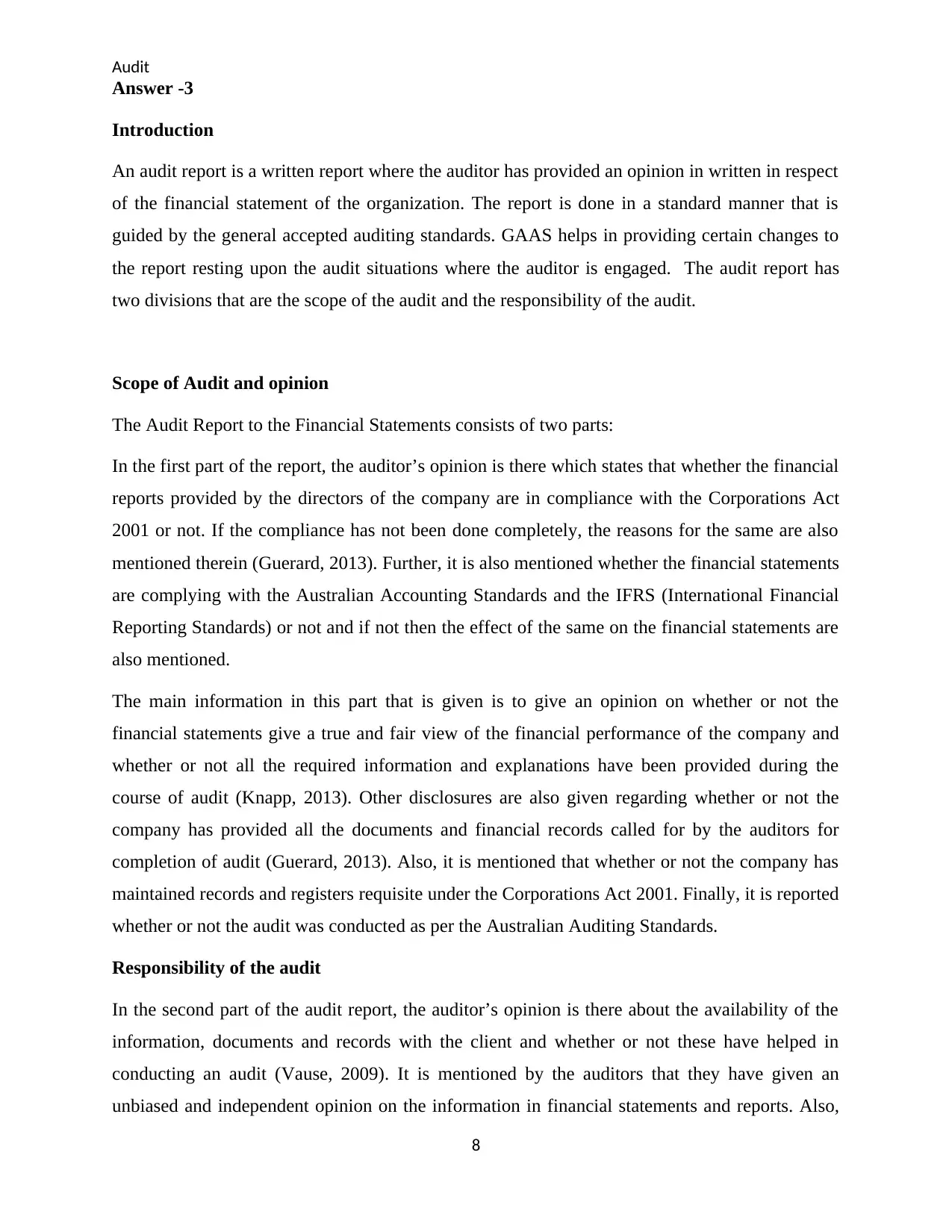
Audit
Answer -3
Introduction
An audit report is a written report where the auditor has provided an opinion in written in respect
of the financial statement of the organization. The report is done in a standard manner that is
guided by the general accepted auditing standards. GAAS helps in providing certain changes to
the report resting upon the audit situations where the auditor is engaged. The audit report has
two divisions that are the scope of the audit and the responsibility of the audit.
Scope of Audit and opinion
The Audit Report to the Financial Statements consists of two parts:
In the first part of the report, the auditor’s opinion is there which states that whether the financial
reports provided by the directors of the company are in compliance with the Corporations Act
2001 or not. If the compliance has not been done completely, the reasons for the same are also
mentioned therein (Guerard, 2013). Further, it is also mentioned whether the financial statements
are complying with the Australian Accounting Standards and the IFRS (International Financial
Reporting Standards) or not and if not then the effect of the same on the financial statements are
also mentioned.
The main information in this part that is given is to give an opinion on whether or not the
financial statements give a true and fair view of the financial performance of the company and
whether or not all the required information and explanations have been provided during the
course of audit (Knapp, 2013). Other disclosures are also given regarding whether or not the
company has provided all the documents and financial records called for by the auditors for
completion of audit (Guerard, 2013). Also, it is mentioned that whether or not the company has
maintained records and registers requisite under the Corporations Act 2001. Finally, it is reported
whether or not the audit was conducted as per the Australian Auditing Standards.
Responsibility of the audit
In the second part of the audit report, the auditor’s opinion is there about the availability of the
information, documents and records with the client and whether or not these have helped in
conducting an audit (Vause, 2009). It is mentioned by the auditors that they have given an
unbiased and independent opinion on the information in financial statements and reports. Also,
8
Answer -3
Introduction
An audit report is a written report where the auditor has provided an opinion in written in respect
of the financial statement of the organization. The report is done in a standard manner that is
guided by the general accepted auditing standards. GAAS helps in providing certain changes to
the report resting upon the audit situations where the auditor is engaged. The audit report has
two divisions that are the scope of the audit and the responsibility of the audit.
Scope of Audit and opinion
The Audit Report to the Financial Statements consists of two parts:
In the first part of the report, the auditor’s opinion is there which states that whether the financial
reports provided by the directors of the company are in compliance with the Corporations Act
2001 or not. If the compliance has not been done completely, the reasons for the same are also
mentioned therein (Guerard, 2013). Further, it is also mentioned whether the financial statements
are complying with the Australian Accounting Standards and the IFRS (International Financial
Reporting Standards) or not and if not then the effect of the same on the financial statements are
also mentioned.
The main information in this part that is given is to give an opinion on whether or not the
financial statements give a true and fair view of the financial performance of the company and
whether or not all the required information and explanations have been provided during the
course of audit (Knapp, 2013). Other disclosures are also given regarding whether or not the
company has provided all the documents and financial records called for by the auditors for
completion of audit (Guerard, 2013). Also, it is mentioned that whether or not the company has
maintained records and registers requisite under the Corporations Act 2001. Finally, it is reported
whether or not the audit was conducted as per the Australian Auditing Standards.
Responsibility of the audit
In the second part of the audit report, the auditor’s opinion is there about the availability of the
information, documents and records with the client and whether or not these have helped in
conducting an audit (Vause, 2009). It is mentioned by the auditors that they have given an
unbiased and independent opinion on the information in financial statements and reports. Also,
8
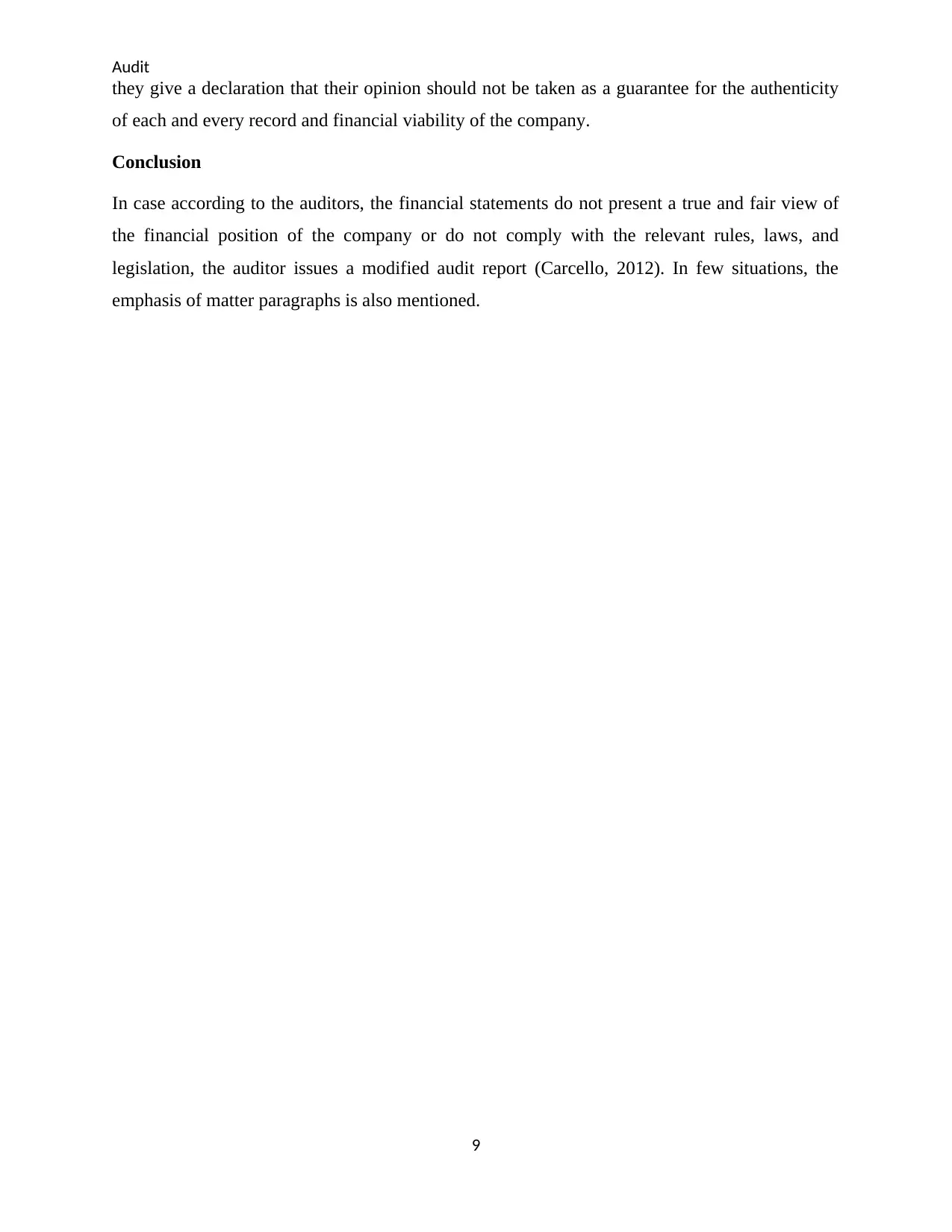
Audit
they give a declaration that their opinion should not be taken as a guarantee for the authenticity
of each and every record and financial viability of the company.
Conclusion
In case according to the auditors, the financial statements do not present a true and fair view of
the financial position of the company or do not comply with the relevant rules, laws, and
legislation, the auditor issues a modified audit report (Carcello, 2012). In few situations, the
emphasis of matter paragraphs is also mentioned.
9
they give a declaration that their opinion should not be taken as a guarantee for the authenticity
of each and every record and financial viability of the company.
Conclusion
In case according to the auditors, the financial statements do not present a true and fair view of
the financial position of the company or do not comply with the relevant rules, laws, and
legislation, the auditor issues a modified audit report (Carcello, 2012). In few situations, the
emphasis of matter paragraphs is also mentioned.
9
⊘ This is a preview!⊘
Do you want full access?
Subscribe today to unlock all pages.

Trusted by 1+ million students worldwide
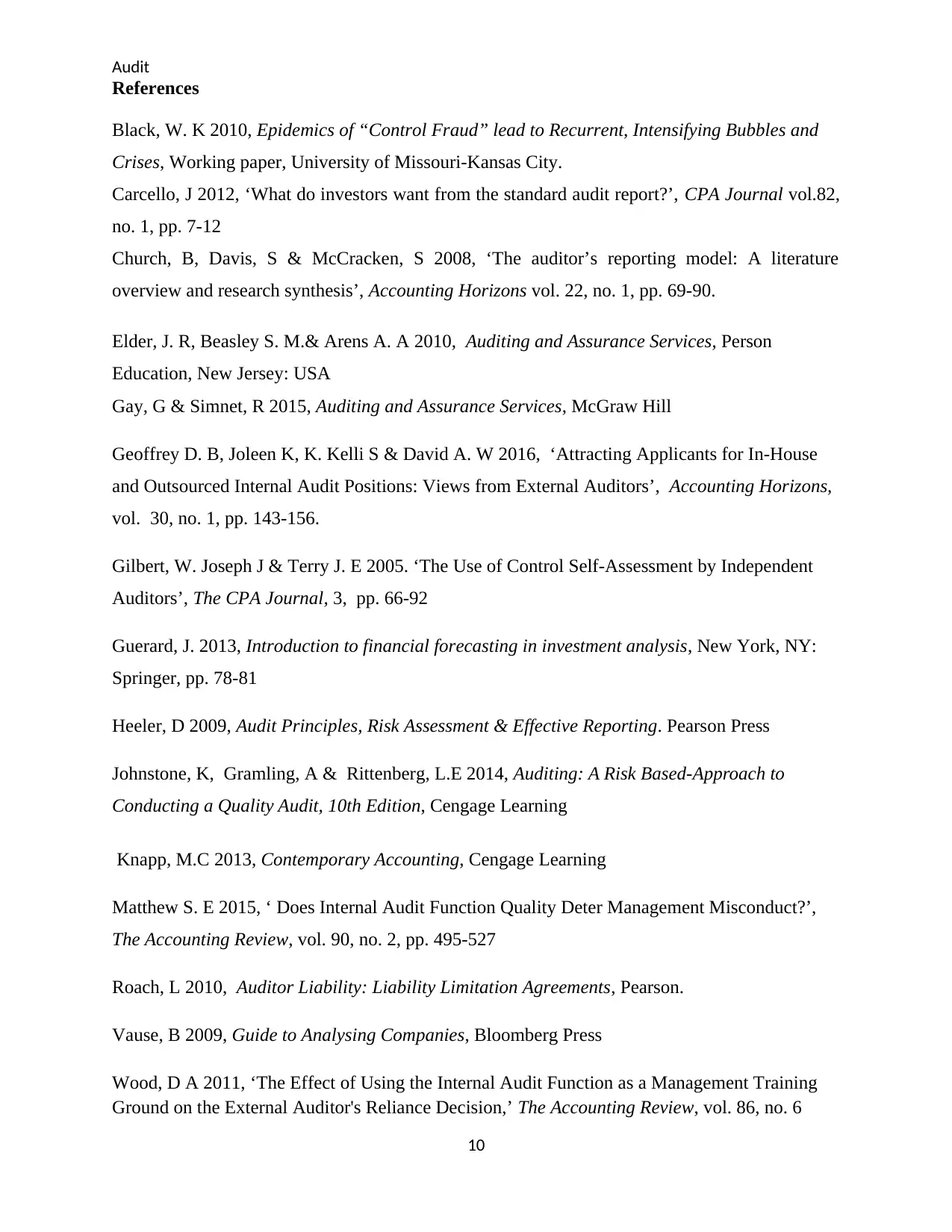
Audit
References
Black, W. K 2010, Epidemics of “Control Fraud” lead to Recurrent, Intensifying Bubbles and
Crises, Working paper, University of Missouri-Kansas City.
Carcello, J 2012, ‘What do investors want from the standard audit report?’, CPA Journal vol.82,
no. 1, pp. 7-12
Church, B, Davis, S & McCracken, S 2008, ‘The auditor’s reporting model: A literature
overview and research synthesis’, Accounting Horizons vol. 22, no. 1, pp. 69-90.
Elder, J. R, Beasley S. M.& Arens A. A 2010, Auditing and Assurance Services, Person
Education, New Jersey: USA
Gay, G & Simnet, R 2015, Auditing and Assurance Services, McGraw Hill
Geoffrey D. B, Joleen K, K. Kelli S & David A. W 2016, ‘Attracting Applicants for In-House
and Outsourced Internal Audit Positions: Views from External Auditors’, Accounting Horizons,
vol. 30, no. 1, pp. 143-156.
Gilbert, W. Joseph J & Terry J. E 2005. ‘The Use of Control Self-Assessment by Independent
Auditors’, The CPA Journal, 3, pp. 66-92
Guerard, J. 2013, Introduction to financial forecasting in investment analysis, New York, NY:
Springer, pp. 78-81
Heeler, D 2009, Audit Principles, Risk Assessment & Effective Reporting. Pearson Press
Johnstone, K, Gramling, A & Rittenberg, L.E 2014, Auditing: A Risk Based-Approach to
Conducting a Quality Audit, 10th Edition, Cengage Learning
Knapp, M.C 2013, Contemporary Accounting, Cengage Learning
Matthew S. E 2015, ‘ Does Internal Audit Function Quality Deter Management Misconduct?’,
The Accounting Review, vol. 90, no. 2, pp. 495-527
Roach, L 2010, Auditor Liability: Liability Limitation Agreements, Pearson.
Vause, B 2009, Guide to Analysing Companies, Bloomberg Press
Wood, D A 2011, ‘The Effect of Using the Internal Audit Function as a Management Training
Ground on the External Auditor's Reliance Decision,’ The Accounting Review, vol. 86, no. 6
10
References
Black, W. K 2010, Epidemics of “Control Fraud” lead to Recurrent, Intensifying Bubbles and
Crises, Working paper, University of Missouri-Kansas City.
Carcello, J 2012, ‘What do investors want from the standard audit report?’, CPA Journal vol.82,
no. 1, pp. 7-12
Church, B, Davis, S & McCracken, S 2008, ‘The auditor’s reporting model: A literature
overview and research synthesis’, Accounting Horizons vol. 22, no. 1, pp. 69-90.
Elder, J. R, Beasley S. M.& Arens A. A 2010, Auditing and Assurance Services, Person
Education, New Jersey: USA
Gay, G & Simnet, R 2015, Auditing and Assurance Services, McGraw Hill
Geoffrey D. B, Joleen K, K. Kelli S & David A. W 2016, ‘Attracting Applicants for In-House
and Outsourced Internal Audit Positions: Views from External Auditors’, Accounting Horizons,
vol. 30, no. 1, pp. 143-156.
Gilbert, W. Joseph J & Terry J. E 2005. ‘The Use of Control Self-Assessment by Independent
Auditors’, The CPA Journal, 3, pp. 66-92
Guerard, J. 2013, Introduction to financial forecasting in investment analysis, New York, NY:
Springer, pp. 78-81
Heeler, D 2009, Audit Principles, Risk Assessment & Effective Reporting. Pearson Press
Johnstone, K, Gramling, A & Rittenberg, L.E 2014, Auditing: A Risk Based-Approach to
Conducting a Quality Audit, 10th Edition, Cengage Learning
Knapp, M.C 2013, Contemporary Accounting, Cengage Learning
Matthew S. E 2015, ‘ Does Internal Audit Function Quality Deter Management Misconduct?’,
The Accounting Review, vol. 90, no. 2, pp. 495-527
Roach, L 2010, Auditor Liability: Liability Limitation Agreements, Pearson.
Vause, B 2009, Guide to Analysing Companies, Bloomberg Press
Wood, D A 2011, ‘The Effect of Using the Internal Audit Function as a Management Training
Ground on the External Auditor's Reliance Decision,’ The Accounting Review, vol. 86, no. 6
10
1 out of 10
Related Documents
Your All-in-One AI-Powered Toolkit for Academic Success.
+13062052269
info@desklib.com
Available 24*7 on WhatsApp / Email
![[object Object]](/_next/static/media/star-bottom.7253800d.svg)
Unlock your academic potential
Copyright © 2020–2025 A2Z Services. All Rights Reserved. Developed and managed by ZUCOL.





